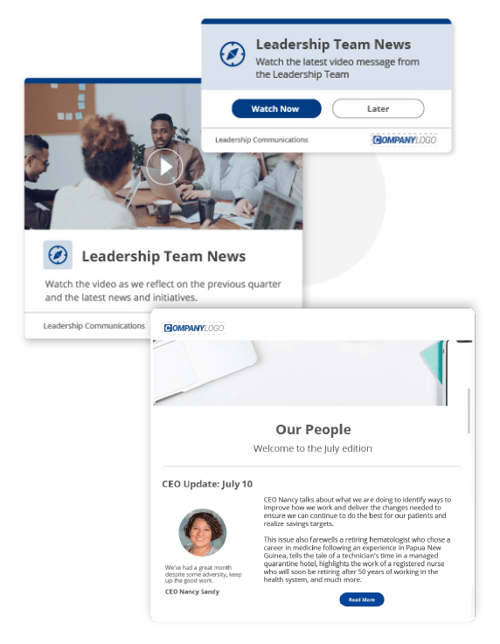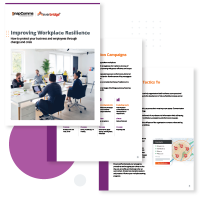
Resilient workplaces are more successful ones. But resilience is hard to achieve when businesses and their employees face the constant challenge of change and crisis.
To understand how to improve workplace resilience, we need to know why it matters, what influences it, and how operational and employee resilience are related.
We spoke with behavioral scientist Steve Crimando, principal and founder of operational risk management consultancy Behavioral Science Applications LLC. Steve has worked with major organizations for many years, and is a recognized expert on the subject.
Read our full conversation with Steve on resilience, communications and black swans, or watch the summary video below. Then for strategies you can use to put all this into practice, download our workplace resilience guide.
Why does resilience matter in business today?
As we grow in population, as the world becomes closer, it becomes increasingly likely for us to have different sorts of crises that can be disruptive.
As dangerous events become more complex, as they become more sophisticated, organizations need to understand that the likelihood of disruptive events increases. So the need for resilience increases right alongside that.
What priority should employers place on building resilience?
I think the importance of resilience for any sort of employer has increased significantly over the last five years, and even more so in the last two where we’ve been affected by the pandemic. It's really demonstrated just how vulnerable organizations can be, even very robust and well-run organizations.
When I think about what the future holds, there are a host of different shifting geopolitical stressors and climate stress and a number of other things that’ll be happening simultaneously. It becomes that much more important, probably more important than any other time I can think of in business, for employers to understand the importance and really focus attention on resilience.
What are the implications of organizations not focusing on resilience?
The lack of attention to resilience can be very costly on the bottom line performance. Morale and cohesion among team members can suffer greatly. The trickle down or cascading effects of that play out in terms of employee recruitment and retention and reputation for the brand.
 “There is no place that is not touched in some way from the potential negative consequences of poor resilience or a lack of attention to resilience by an organization.”
“There is no place that is not touched in some way from the potential negative consequences of poor resilience or a lack of attention to resilience by an organization.”
Steven M. Crimando, MA, BCETS, CHPP, CTM
Principal and founder - Behavioral Science
How are employee resilience and operational resilience related?
Operational and employee resilience absolutely go hand in hand. They are two parts of the same equation. We can't have good, resilient systems without the people who operate them. We can't have people doing their jobs well without robust and resilient systems.
So it's always a two part equation and it requires attention equally to both of those categories because they increasingly co-mingle and they are increasingly dependent on each other.
What are some of the causes for low employee resilience?
When I think about employee resilience today, one of the main causes is people being hit with compound stressors. It’s not just the stress from work that they carry home. It's not just the stress from home that they might bring to the workplace.
There's a whole host of different ambient stressors that have to do with the pandemic and post-pandemic environment, with the economy and inflation, with all the different problems that are swirling around us. And they have a compounding effect in that it becomes difficult sometimes for people to sort out or to escape those stressors when they're almost always operating in the background.
So it's no longer people dealing with a single stressor or even multiple stressors. It's really the effect of these compound stressors that are hitting people from all different angles. It becomes that much more difficult for them to navigate.
 “Resilience is something that is done with employees, not done to employees. It needs to be not just transparent, but participatory. Balancing operational resilience and psychological resilience works best when it’s embraced by everyone and it saturates the culture.”
“Resilience is something that is done with employees, not done to employees. It needs to be not just transparent, but participatory. Balancing operational resilience and psychological resilience works best when it’s embraced by everyone and it saturates the culture.”
Steven M. Crimando, MA, BCETS, CHPP, CTM
Principal and founder - Behavioral Science
What advice would you give to employers to start building their resilience? Which areas should they address first?
It's very easy for employers to look for the technical solution. We're increasingly technical societies and we tend to go towards technology to look for solutions where we can.
What’s going to be at the forefront moving forward is how we blend those technologies with the human element. The challenge is to find the balance and to find the synergy where those two elements work well together in somewhat equal attention, and to understand that one on its own isn’t the perfect solution.
So when we think about what employers should do, it’s making sure that they understand the operational aspects of resilience, but also to be aware of how sensitive the human element is to changes and how they need to focus equal attention on that if they're going to address resilience in a holistic manner.

What role do communications play in strengthening resilience both for employees and for the business?
Communications are so key because one of the greatest forms of stress that any organization has, and this cuts both ways for employees and employers, is the unknown. It's when we're making assumptions about what other people may be thinking or how they're feeling, and it's not communicated.
We are much better suited psychologically to even knowing bad news than to not knowing and imagining what's going on around us when communications are not optimal. It leaves employees guessing about the mindset of their supervisors and executive management and the direction things are moving.
And when supervisors are not getting that feedback from employees, it leaves them guessing about the mindset and psychological condition of the workforce, where based on those assumptions they can make the wrong move. They can actually shift in a direction that is not only ineffective, but actually can be counterproductive.
 “Communications create a sense of transparency. It eliminates some of the unknown. If we decrease uncertainty through good and transparent communications, it does a wealth of good in terms of developing and sustaining resilience in an organization.”
“Communications create a sense of transparency. It eliminates some of the unknown. If we decrease uncertainty through good and transparent communications, it does a wealth of good in terms of developing and sustaining resilience in an organization.”
Steven M. Crimando, MA, BCETS, CHPP, CTM
Principal and founder - Behavioral Science
What does the black swans analogy mean for workplace resilience?
Black swans are very often thought of as those very rare one-off adverse events that were unforeseeable and very disruptive to an organization. And they're no longer that unforeseeable.
Today we're living in an era that's probably characterized as a flock of black swans because so many disruptive events seem to be coming at us from all different angles. So it becomes more important for organizations to not just be able to take one hit and rebound quickly and fully, but to be able to almost constantly be taking hits of different magnitude and to bounce back into operational condition as quickly as possible.
So rather than today planning for that one big one, it's really planning for a constant stream of probably smaller crises, but an ongoing stream.
Download: Guide to Improving Workplace Resilience

Proactive, engaging communication prepares your organization and workforce for potential risks. Download your free guide for practical examples, strategies and tips for building workplace resilience.

